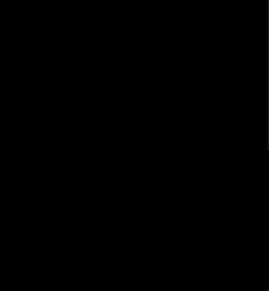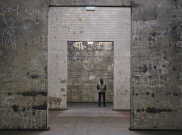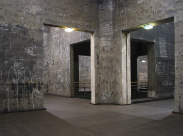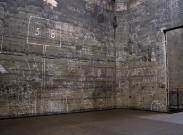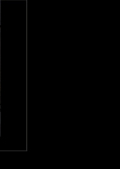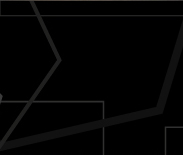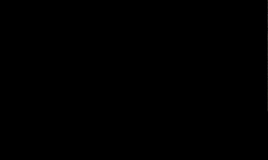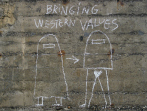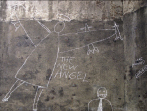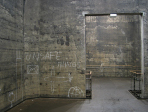![]() Dan Perjovschi: "White Chalk - Dark Issues"
Dan Perjovschi: "White Chalk - Dark Issues"
"the project in Brukenthal is on the same plan as that
one in Essen and the future one in Kunsthalle Goppingen (all in "German"
spaces), or from one to the next one, as a sort of chapters of the same book.
This year I have drawn on the walls. Ceaseless."
"the drawings thwack you in the head when you enter the halls, as they
surround you from the ankle 7 meters over head… it looks to me quite
baroque, a sort of Sistine Chapel in rendez-vous to the Lascaux cave and with
a Jilava flavor." (Dan Perjovschi)
For Dan Perjovschi international recognition came with his extensive installation
"rEST" in the Romanian pavilion at the 1999 Venice Biennale. Perjovschi
covered the floor of the pavilion with drawings, doodles and political graffiti
that look at life under post-communism as well as the role of Eastern European
art in the cultural exchange with the West. Perjovschi regards the artist's
role in the post-socialist era as primarily political. He is the co-founder
of the opposition weekly "22" and has been its political illustrator
and art director since 1991. As artist in residence Perjovschi will spend
four months covering the whole second floor (Bunkerebene) of the Kokerei Zollverein
with his graffiti and chalk drawings. This project considers both the transformation
of the Kokerei complex from industrial plant into a site of cultural production
and the transition in Eastern Europe to a phase of political and cultural
reorientation. The work will cover an area of 700 square metres with a historical
panorama that also reflects the contemporary global political situation. (Marius
Babias)
In the 2003 annual project "The Open City: Models for Use" the Kokerei Zollverein | Zeitgenössische Kunst und Kritik initiates an artistic discourse on the public sphere. How does a public sphere arise? How does it become influential? For decades, the grounds of the former coking plant Kokerei Zollverein constituted a "forbidden city".
The Kokerei Zollverein was built between 1959-61 and remained in operation until 1993. It was based on plans drawn up by Fritz Schupp, who created a technically and formally distinct style of architecture. In 2001 the Zollverein with its colliery and coking plant was declared a UNESCO world heritage site. Today it is a public space. The "forbidden city" has become a "public city", a complex that is also a witness to industrial and social history. The overall project of the Kokerei Zollverein | Zeitgenössische Kunst und Kritik, initiated in 2001, aims to establish a site for the production of ideas, communication and criticism on the grounds of the former industrial plant.
From the "Open City" to "Open Society"
The 2003 annual project "The Open City: Models for Use" operates
on three different levels. Firstly, it addresses the transformation of the
Kokerei Zollverein from a "forbidden city" into a "public city".
Secondly, it aims to illustrate the historic transition of public art from
outdoor sculpture in public places to the project art of the 1990s, whose
form is no longer exclusively bound to external space, but which instead intervenes
directly in the structures and media of politics and society. And thirdly
its objective is to formulate an art practice that goes beyond the boundaries
of project art and reaches the "open society" in the areas of art
and feminism, everyday life, culture jamming and urban theory.
The aim is to create user models for resistance in the fine arts, internet
culture, politics and the media. With the rise of project art in the 1990s
by the very latest the artist's role had begun shifting toward the role of
cultural producer. Project art, a term used to describe an artistic practice
that functions outside traditional parameters in fields of conflict in society,
politics and the media, is not tied to a specific medium, nor is it solely
institutionally based.
The 2003 project "The Open City: Models for Use" does not exhibit plans and proposals related to the theme. Instead it represents both the starting point and the meeting point for a critical questioning of the public sphere and the ways in which it emerges and functions. What links the project's many artistic interventions, publications and projects is their search for new forms of critical public awareness. They respond to the prevailing ideology and resist the neoliberal redefinition of art and culture as lifestyle services whose role is to enhance their clients' public image.
The overall project "The Open City: Models for Use" deliberately eschews setting up a central focus or a doctrinaire definition of the public sphere. Instead the individual elements are provided with a framework that keeps them formally separate but thematically linked and allows scope for their autonomous development. The hope is that the criss-crossing perspectives of these essays, statements, works of art, arguments and projects will create a system of reference that, in turn, produces new forms of public sphere in the "open society".
Marius Babias: Head of communication
Kokerei Zollverein | Zeitgenössische Kunst und Kritik, Essen

